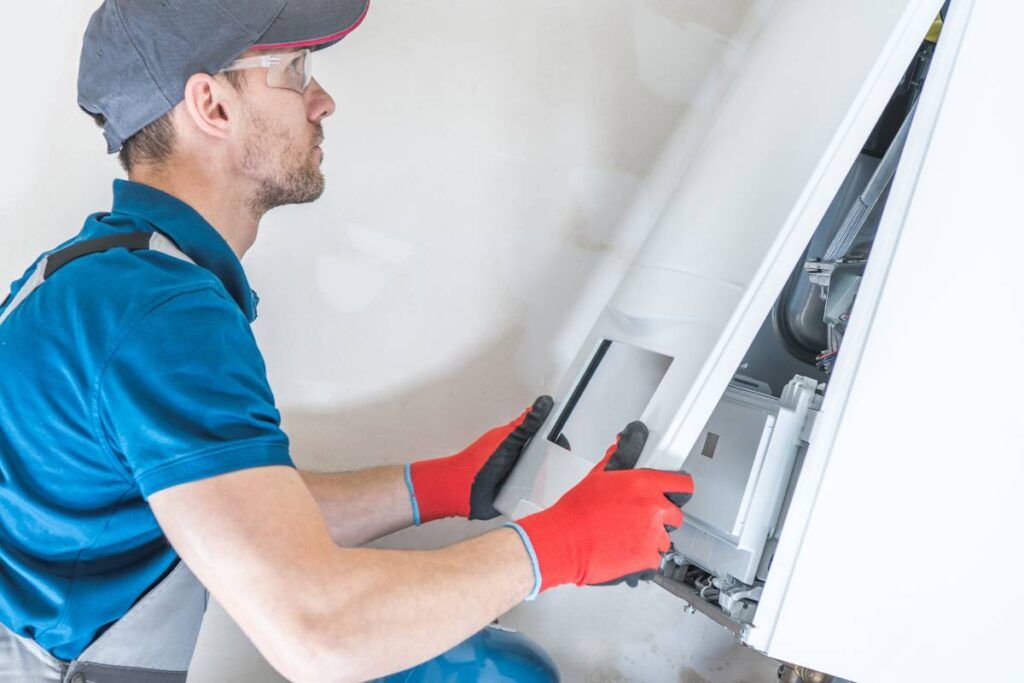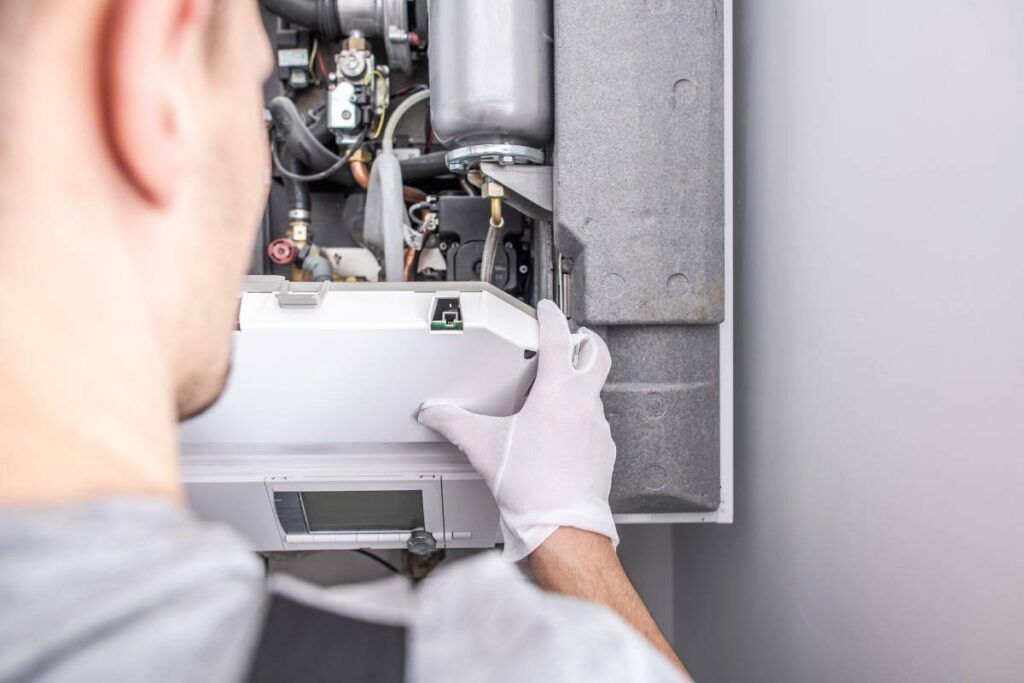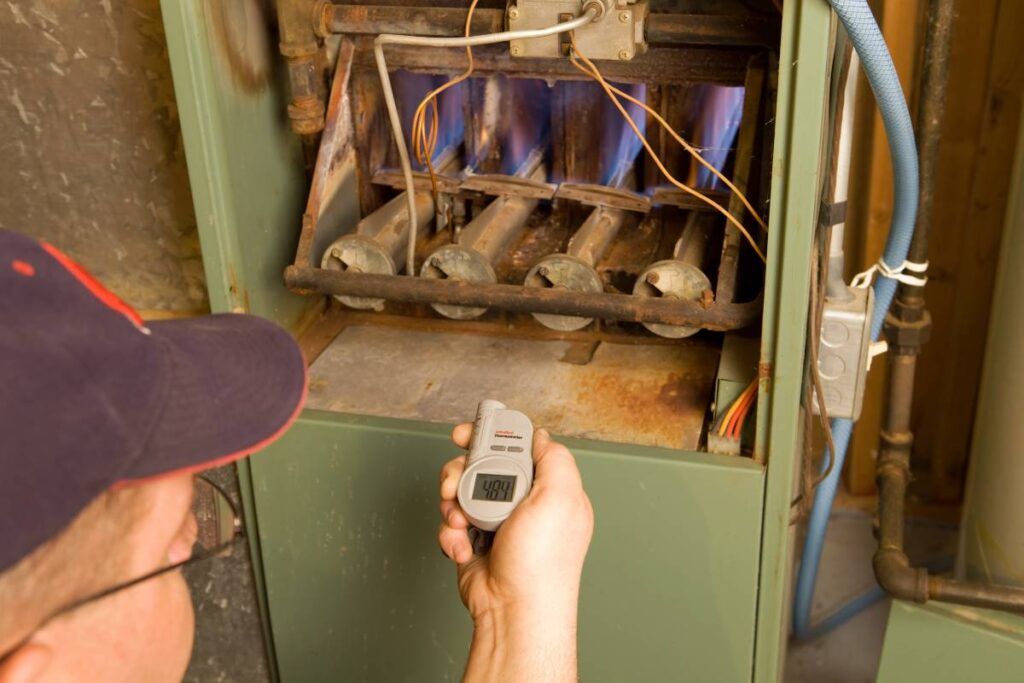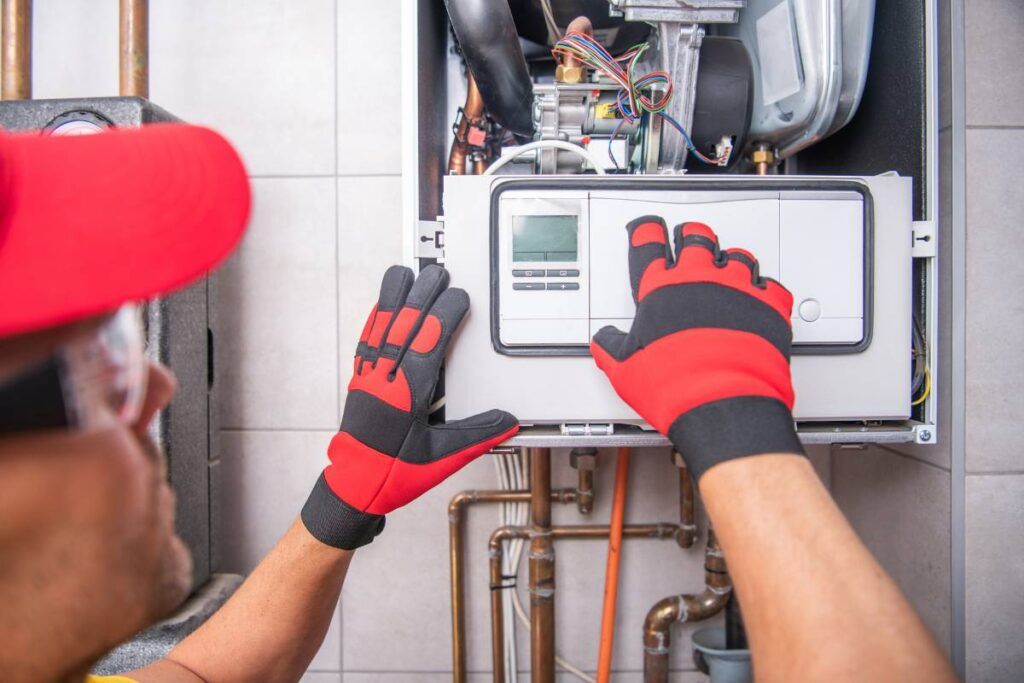The best thing about furnaces is you receive warm and comfortable air even during harsh winter. But the worst thing is the unit fails to start sometimes. This article will explore the various reasons behind a furnace not turning on.
A furnace does not start due to tripped breakers, thermostat problems, clogged filters and condensates, dirty flame sensors, or safety switches. Potential fixes include checking the breakers, cleaning the furnace filters and ignition, and emptying the condensate drains.
Even if you need an expert’s help fixing the furnace, knowing how to solve some problems can save time and money. Since there are multiple reasons, cross-check the reasons to confirm it and then approach troubleshooting. Now let’s get to the reasons right away.

Check out our list of top-handpicked products for all your electrical, appliance, and HVAC system needs to keep your home running smoothly.
This post includes some affiliate links.1. Tripped breaker
When the breaker connected to the furnace trips, your furnace will not turn on.
It occurs when the same breaker powers too many heavy-duty appliances and ultimately trips off due to overloading.
Overloading can lead to short circuits.
Tripping off the breaker means it is protecting itself from severe short circuits.
Sometimes, it could be due to some ground fault.
How to fix it?
When a breaker trips, the handler will remain in the center between the ON and OFF switches.
You need to reset the breaker.
To resetting it:
- Make sure that the switches and plugs in the room are turned off.
- Open the breaker box and find the tripped breaker switch. It will be easy to find because the electricians mark the breaker for easy finding.
- Suppose the breaker is between the ON and OFF positions. First, move it to the OFF position, wait for some minutes, and then turn it ON.
- If the breaker is already in the OFF position, push it straight to the ON position.
These steps should solve the problem.
But, if the switch doesn’t turn ON or re-trips after resetting, do not reset it again.
Please turn it off and call for the HVAC team’s help.
Check for damaged wires, switches, or fixtures.
2. Thermostat problem
Thermostat problems are common.
It could be due to wrong thermostat settings, wire issues, or dead batteries.
Setting the thermostat to OFF or COOL won’t let the unit start.
Some thermostats have low battery indicator settings that inform you about low batteries.
Other reasons could be dust buildup, dead fuse, time error, or incorrect repair.
How to fix it?

The solutions will differ based on the exact problem.
For the wrong thermostat setting, set the thermostat to HEAT and not OFF or COOL.
Make sure the temperature is at least 5°F above the room temperature.
If the thermostat is dusty, open the device and blow the dust away.
Use a soft brush to clean it, but be careful of the wires.
Replace the dead batteries. Use batteries that suit your thermostat model.
Call an expert if there are any electrical wire faults, like loose or frayed wires.
Replace a dead or blown-up fuse, and make sure that the fuse matches the thermostat’s make and model.
Sometimes, incorrect times and dates are the culprits.
Ensure that the thermostat has the correct times, dates, and timer.
If you still cannot figure it out, contact an HVAC expert.
3. Clogged furnace filter
Over time, the furnace filters accumulate dust and debris, compromising the furnace’s efficiency.
Check the filter monthly and replace it every 3-4 months for smooth functioning.
A clogged furnace will make a humming noise, indicating dirty air filters.
Ignoring will make the furnace will stop working after some weeks of humming.
If a new filter gets easily clogged, the possible reasons could be:
- Mold and soot
- Excessive carbon monoxide
- Damaged vents
How to fix it?

If the filter is dirty, remove it, clean it, and then put it back in the furnace.
Sometimes a clogged filter means it has worn out over time and requires replacement.
Open the furnace cover and replace it.
Make sure the filter is installed in such a way that airflow can circulate properly.
If the culprit is carbon monoxide, mold, or damaged vents, you may require an HVAC expert’s help to fix the problem.
4. Dirty or faulty furnace flame sensor
The ignition or flame sensor inside the furnace is an essential part of the furnace that senses the flame and fires the furnace.
If the flame sensor is dirty or faulty, it won’t sense the flame, and the furnace will not turn on.
The furnace will click, but it won’t start or shut down immediately after turning it on.
How to fix it?
Remove and clean the dirty sensor and then put it back in place.
If the flame sensor is at fault, replace it.
Here are the steps to clean or replace the flame sensor:
- Turn off the main power at the breaker.
- Close the gas valve.
- Unscrew the sensor and pull it out of the furnace.
- Check the sensor properly to see whether it is dirty or damaged.
- See the porcelain base with the metal rod and loosen the screws to remove it.
- Use a clean rod with steel wool or a knife and remove the buildup.
- You can also use an emery cloth to clean the dirt, for example, a 3M Emery cloth, 03008, 3 ⅔ in x 9 in, 6 sheets per pack.
- If the sensor is damaged, cracked, or has missing pieces, replace it.
- Reinstall the sensor, switch on the furnace, open the gas valve, and fire the furnace.
If the problem persists, you need an HVAC expert.
If the furnace works after cleaning, you do not have to replace it. Only do it if the furnace remains off after cleaning.
5. The furnace gas supply interrupted
The unit will not turn on if the gas line does not send gas to the furnace.
The new furnace models have an automatic combination gas valve to control the gas supply and pressure regulator.
So, issues with the gas valve mean an interruption in the gas supply.
The gas valve will open and close for the gas flow to the furnace burners and pilot light.
What should I do?

Check the gas flow by turning on other appliances that run on gas.
If the appliances work, the interruption is due to some furnace problems.
You need to figure out that first.
Some possible checkings you must do are:
Gas line and gas valve
Check the gas valve of the furnace to ensure it is open.
A closed valve will indicate a problem in the gas line.
Call a professional if the valve is closed.
When the other gas appliances run properly, the problem is not with the gas valve or gas line.
But if none of the gas appliances are running, check the main gas valve controlling the gas flow and make sure it is turned on.
The gas valve will be beside the furnace and look like a box with a disk or a lever with the thumb size.
It will sit over the gas line around 6 feet from the unit.
If the lever is parallel to the gas pipe, the valve is open and closed if the level is perpendicular.
Check the street valve
If the gas valve is open, check the street valve.
Sometimes, the utility technicians close the valve after the gas line maintenance.
If both valves are open, contact the natural gas provider from your locality to look into the matter.
Check the pilot light.
Most of the furnaces will have a pilot light that lights up whenever the gas flows to the furnace.
If the light remains off, it indicates the gas is not flowing, and there is some problem.
Here too, the HVAC expert must handle the matter.
If you see any signs of leakage or bad smell, immediately turn off the gas supply valve and contact the supply company.
6. The pilot light is not working
As I mentioned earlier, the pilot light indicates the gas flow to the furnace.
If the pilot light does not light up, your furnace will not ignite and heat your room.
It requires the HVAC’s attention. They will fix the light and reignite or replace the pilot light if needed.
7. Bad blower motor

The blower motor in the furnace circulates air from the unit to the vents and your house.
If the motor fails to work well, the whole heating system of your house gets compromised.
Common causes behind a bad blower motor are insufficient power, burnt out, or weak capacitor.
A malfunctioning blower motor’s symptoms are burning smells, humming sounds, and furnaces not turning on.
If the furnace shows a blinking green light, it indicates something is wrong with the blower motor.
Overheating can also signify dirt buildup in the motor, making the heat unable to reach the vent.
How to fix it?
Fixing a blower motor is quite tough if you are not a professional.
If the problem is insufficient power, turn off the unit, and check the motor on the right side of the unit.
If the blower has tried to turn off multiple times, it will be hot.
Replace the motor by consulting with the HVAC expert.
8. The blower capacitor is dead
The capacitor is a battery-like part of the furnace attached to the blower.
The blower capacitor signals the ignitor when the thermostat tells it to provide the power required by the blower to start the fan.
Try checking the capacitor.
Check the capacitor with a meter to confirm that the level matches the label. If not, you have to replace the capacitor with the help of an expert.

Some common signs of a bad capacitor are:
- Overheating – It will trigger the safety switch, and the unit won’t turn on.
- Burning smells – It happens when the furnace has frayed or corroded capacitor wires and a faulty power supply.
- Slow and overheating furnace blower – It indicates that the capacitor does not have the changes required by the blower for running.
A weak and faulty capacitor does not let your blower motor function properly.
How to fix it?
A faulty capacitor is common and easy to fix, provided it is broken and not something else.
- Turn off the furnace power at the breaker.
- Open the panel to check the capacitor furnace.
- Get an identical capacitor matching the make and model of your existing furnace.
- Remove the old one by removing the screws and then plug in the new one.
- Fix the wires properly. Take a photo before removing the capacitor to remember all the positions.
- Close the panel and check the furnace.
Inspecting the capacitor during the annual maintenance may confirm the problem.
Changing during that time will prevent the problem and encourage smooth functioning.
9. Damaged or cracked heat exchanger
The furnace heat exchanger separates the combustion from the air exchange.
It contains metal chambers and passages from the burner assembly to the chimney vent.
If the exchanger is faulty or damaged, the furnace won’t start. Even if it starts, it will fail to fire up properly.
Some common symptoms are:
- Cracks near the heat exchanger’s seams
- Discoloration due to mold and doot escaped from the cracks
- A jumping flame due to the cracks that allow the air to mix with the air
A bad heat exchanger will cause ignition failure due to toxic carbon monoxide leakages.
A cracked exchanger can also indicate other issues like low airflow.
How to fix it?
The best solution is to replace the heat exchanger. Hire an HVAC expert.
If the damage on the heat exchanger is due to an aged furnace, buy a new furnace system.
10. Too much gas burning
Furnace manufacturers include specifications about the volume of gas a furnace must burn.
A house owner regulates the furnace settings for more heat when the house is frigid.
So, it will burn more gas than the recommended amount.
It will overheat and automatically trigger the safety switch, which won’t allow your unit to turn back.
Besides, more gas means high expenses.
How to fix it?

You cannot do much except for the thermostat setting.
Ensure the annual maintenance of your unit.
It will have a combustion analysis to check the amount of gas the furnace burns.
If you set your furnace to high heat levels, turn it back to the recommended level.
Ask for the HVAC’s advice if you are unsure about the problem.
11. Condensate pan not draining
The condensate drain pan inside the furnace unit works like a container collecting condensed moisture.
It has a drain and a pump to remove the moisture and send it to the wastewater drainage system.
If the condensate pan’s pump does not work properly or there is a blocked drain, the float switch will get triggered and stop your furnace from turning on.
How to fix it?
To fix the problem, confirm that the condensate pan’s drain is clogged or the pump is jammed.
Jammed pump
If the pump is jammed due to dirt, you must clean it and move it if it gets stuck.
Clean your hands after working with the pump, as the condensed water will have acid.
If cleaning does not fix your furnace, replace the pump with the HVAC expert’s help.
A clogged condensate pan drain
Clean and remove the dirt clogging the drain pan.
Adding condensate pan tablets can help in cleaning the drain.
For example, SimpleAir Clean Flow HVAC Drain Line Treatment tabs, 6 counts.
These tablets get activated by moisture and prevent clogging for at least 2 months.
Once you have cleaned the pump and the pan drain, turn on the furnace switch.
If everything is fine, the unit should turn on within a minute.
12. Blockage in the airflow
The furnace must have enough airflow inside and outside for efficient functioning.
Shift your attention to the airflow if you have checked all the above reasons.
An outside element might block the airflow at the PVC pipe.
If the fumes cannot exit, the furnace will stop working.
Additionally, furniture can block the airflow at the vents and prevent the warm air from entering your house, causing overheating.
As a result, the furnace will shut off and not turn on again due to overheating.
How to fix it?

Check the warm air outlets and the vents for blockage.
See the outdoor vents to check that the PVC pipes are not near any objects or furniture, as they may block the air.
Make sure that the vents are clear.
13. The furnace power is switched off.
You will see the furnace not turning on for silly reasons like switched off.
Sometimes the furnace has its power switch above or near the unit.
House owners mistake this switch as the light switch and turn it off.
The fix for this problem is simple.
You need to be aware of the furnace switch and turn it on when you need it.
Turn on the switch to start your furnace.
14. Tripped high-limit switch
When your furnace does not turn on, the result could be a tripped high-limits switch.
This switch helps communicate the temperature inside the furnace to the thermostat to turn on the blower motor.
It is a safety feature that turns off your furnace and does not turn it on when the unit gets overheated.
The switch will also trip if it is dirty, damaged, or requires replacement.
Hire an HVAC expert to replace the switch.
If the switch has tripped due to overheating, let your furnace cool down for a bit and then turn it on, or find out the reason behind the overheating.
15. Triggered pressure switch

The pressure switch is another safety feature that turns your unit off when it senses the exhaustion of the flue gas.
When the switch gets activated, it detects a negative pressure in the unit’s flue pipe or draft inducer motor.
As a result, it stops the harmful exhaust back drafting, which can make you sick and even kill you.
The automatic shutdown will save these gas leaks and your health.
If the pressure switch gets dirty or worn out, it will wrongly trigger your furnace to shut down.
Call an HVAC expert to look into the matter.
When should I call an HVAC team?
Most furnace problems need an HVAC expert’s attention, and some don’t.
Here are 5 furnace problems where you must call the expert without any second thoughts:
- If you have cross-checked all the issues and cannot figure out anything, hire a professional.
- If the furnace releases a gas or propane smell, shut down your unit and call a professional.
- Avoid doing anything yourself, especially if things are related to electrical wirings.
- Immediately call an HVAC professional if the furnace problem is related to the bad motor.
- If the circuit breaker trips more than 2 times, shut down your unit and hire an HVAC team to deal with it.
Final thoughts
Not having routine maintenance of your furnace unit is one of the common reasons behind the unit having so many problems.
Regular checks once or twice a year will inform you what changes your unit requires.
It will help the unit’s smooth functioning for years without any problems.
Since there are multiple reasons behind a furnace not turning on, you must first confirm the problem and troubleshoot it.
Reasons like safety switches get triggered whenever they get a signal that something is wrong with the unit.
These switches save you and your unit from severe problems.
If you are confused about what to do, call an expert.
FAQs
How to reset the furnace?
The furnace will have a reset button attached to the unit.
Press it for a few seconds.
The reset button’s location may vary based on the furnace type.
But it is mostly inside the blower compartment or on the wall near the unit.
If it does not work, reset the breaker.
Also read: Furnace Only Works After Reset: 9 Problem+Fix
Reference: Wikipedia.
